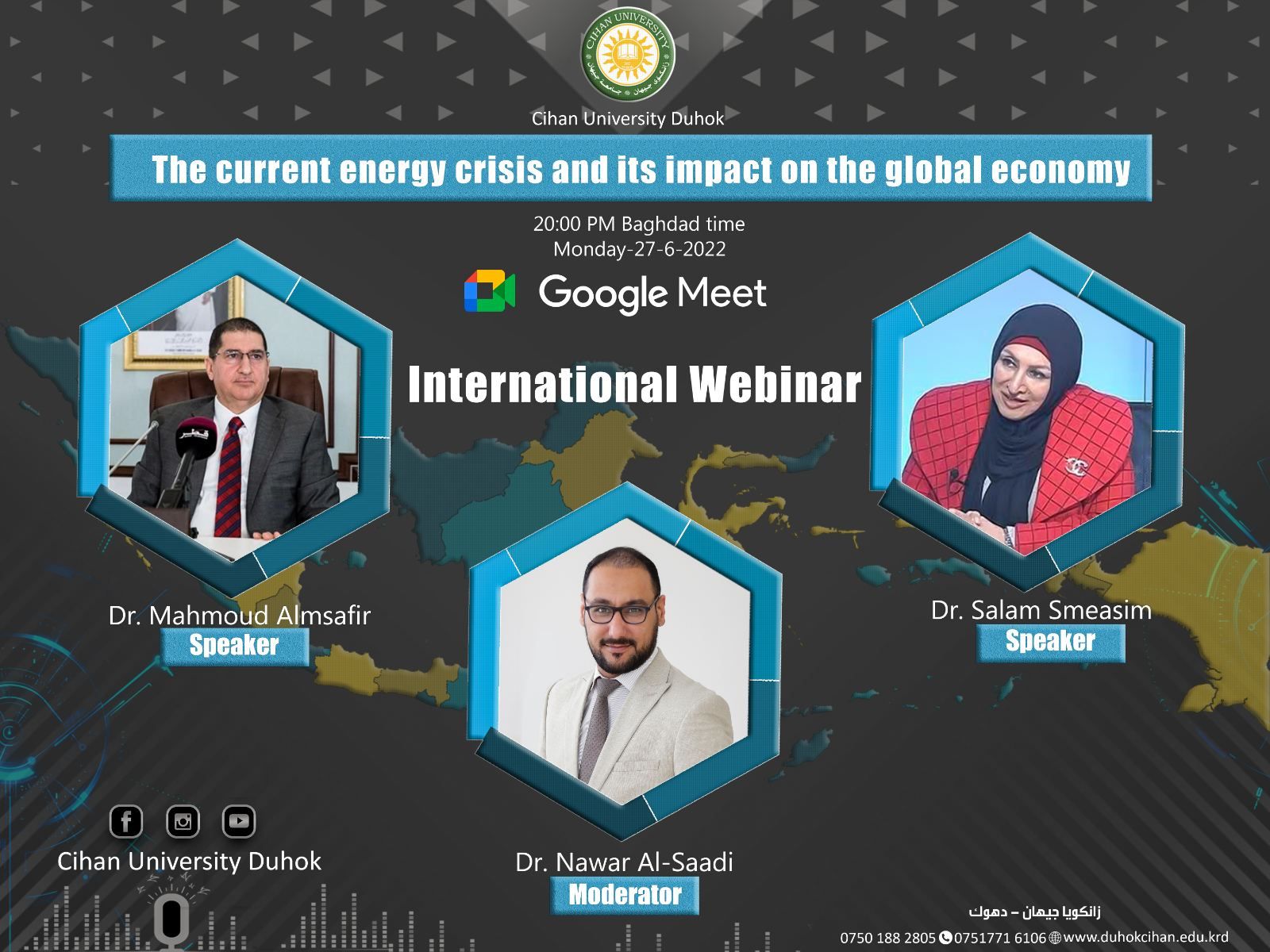
The Research Center at Cihan University- Duhok held an international online workshop last Monday
27.06.2022 entitled “The Current Energy Crisis and Its Impact on the Global Economy” which will be continued for 3 days
Presented by the speakers:
-Dr. Mahmood Al-Musafir, a former diplomat, Vice-Chancellor of UCIS University of Malaysia and former President of Lusail University in Qatar.
– Dr. Salam Sumaisem, an economic expert in the General Secretariat of the former Iraqi Prime Minister.
The session moderated by: Dr. Nawar Al-Saadi, director of the Research Center at our university.
More than 100 academic figures from different universities attended.
Where the following was presented:
The first speaker was Dr. Mahmood, whotouchedon the beginning of the current energycrisis with the beginning of the Russian war – which caused by important political events. The most important event was the Ukraine’s provocation of Russia through its continuous attempts to join the North Atlantic Treaty (NATO) especially after Volodymyr Zelensky’s accessionto the presidency in 2019.It is known that the North Atlantic Treeaty (NATO) was supported and abetted by the United States of America. It is also known that the region was not stable for many reasons, the Russian army invaded Crimea in 2014 after the Orange Revolution in Maidan Europe in Kyiv which overthrew the former president Victor yanukovych, whowas close to Moscow. Then succeeded by positionPetro Yoroshenko, who is close to Washington.
It was immediately followed, in 2015 the Russian army intervened in the war in Syria on the side of the Syrian regime after Syrian President Bashar al-Assad sent a letter to President Vladimir Putin requesting assistance in supporting Syrian forces against what he called extremist armed groups, and at the same time the Western coalition was leading a war in Iraq against the so-called Islamic State of Iraq and the Levant, which in 2014 controlled a third of Iraqi lands and a third of Syrian lands.
This is in terms of the reality of political events in that period, but in terms of the American defense strategy for National interests, the United States is calculating the accounts and preparing to confront China, that economic resource a giant that cannot be stopped easily. And if we take the issue of energy as the most critical and scarce issue in China, we will know that the United States and all the Western parties that support it know that the only way to stop the Chinese development, which brings it daily closer to the first economic position in the world, is to prevent oil and gas from easily reach the yen. And Russia is the rebellious economic and political genie, which has not been able since a year 1990 and until today, to create an atmosphere of reassurance between it and its European neighbors. So it may deviate towards Strategic relations with China include securing the necessary energy sources for its industries and all its economic activities.
It was necessary to confront Russia and determine its export capacity, which may target Upper Asia, on the one hand, and on the other hand, the United States wants to keep Europe under its shadow, especially the economically advanced countries suchas GermanyandFrance. So,NATO, whichlost its prestige inthe past twenty years, especially during Bush presidency, must be re-strengthened. Also, the Ukrainian provocation to Russia continued with the president’s constant demands Ukraine elected Volodymyr Zelensky to join NATO until Russia invaded Ukraine and began a military operation on February 24 of this year 2022.
Europe relies heavily on Russian gas for the production of its electrical energy, and this dependence was an obsession making Western decision makers are thinking and constantly trying to find alternatives to this large relative dependence on Russian gas. the West started to think about Iranian gas and Qatari gas, but the war in Syria and the issue of the program the Iranian nuclear program has prevented the implementation of the West’s plans to obtain an alternative gas to Russian gas. Germany alone, depends on Russian gas for electricity production by 55 percent, and France at around 40 percent and that the process of abandonment sudden loss of Russiangas will leadto major bottlenecks inthe WesternEconomy.But the decisionwas Americanpar excellence. America and Europe imposed sanctions on the Russian economy, and in return the Russian government issued a setof decisions through whichit responded to Westernsanctions, including the most important of whichis selling gas and oil as Russia called them unfriendly countries in Russian rubles.
As a result of theseevents and the inflexibilityof supply for technical and political reasons, the marketwas unable to make up for the shortage that was happening in the supply of gas and oil in the global market as a result of Western sanctions on one hand and the hardening of the side Russia, on the other hand. The supply shock occurred, and prices rose to a very large extent, as each crude oil arrived to 109 dollars per barrel, and the price of gas hits the price of seven dollars per cubic meter, which is multiples what was the price before the crisis.
The crisis led to a rise in fuel prices all over the world and a rise in the prices of all different food, industrial and agricultural products. As a result, economic activities will also decrease due to the deflationary policies led by the central banks inthe worldinattempt to curbinflation.Thus, stagflationwill continue tohit the interests of citizens in all countries of the world, and the burden on the public sector will increase in almost all countries except those that can transfer this burden according to the known market mechanism to the citizen and the private sector companies.
But the repercussions for different countries will vary depending on the economic reality of the country and its proximity or distance to global events that undermine international peace and security. Some oil countries will be more capable than others in facing the rising prices and some of them will suffer complete economic failure. And between the first type of states and the second type are different and dissimilar groups.
Then he concluded his speech by saying, “The Russian-Ukrainian war will not be short and will have its sequels from as far as China in the east east to Europe in the west, and the eye is still open to the region that has the largest gas reserves in the world, which is the so- called Middle East. The crisis will not be resolved unless all outstanding issues are closed today, the area of vital influence Russia, the Iranian nuclear program, the Western-Chinese conflict over Taiwan, and other files.”
As for the second speaker, the economic expert, Dr. Salam Smaisem, she began by saying, do not forget, that the Russian-Ukrainian war contributed greatly in influencing the course of the global economy, the most important of which are the energy and fuel, amid international warnings from organizations concerned with the humanitarian impact of this, which will become evident in a way that cannot be hidden in many regions of the world.
It continues, increasing despite international efforts to search for renewable sources of energy to confront these developing crises often indicates a shortage in one of the energy sources used at a specific time and place, especially those that supply national electricity networks; and that actually happened with the European Union in light of the lack of supply of natural gas on which it relies heavily key in power generation.
From that it becomes clear:
1 – Partial or total lack of energy sources.
2 – It coincided at a specific time for a specific group, which is the European Union in the beginning, and it is first established in networks the main electricity in these countries.
3- From the formation of the crisis and the methods of its management, the observer can conclude that it will turninto a structural crisis and not occasional, as Europe has not experienced, during the last fiveyears, an energy crisis. And in particular, there was not any gap between the forces of supply and demand for energy, and the indicator of this is the abilityof European governments to manage the energyprofile smoothlyduring theseyears, and the ability to meet the challenges of increasing demand and balance it with display; which may suggest that the current energy crisis in Europe, , began as an accidental crisis caused by a set of the most prominent military and political factors as a result of the Russian-Ukrainian war, and it is feared that with time it will turn into structural crisis. Especially when European governments are unable to find practical solutions to respond to the increasingdemandtowards the inflexibilityof supply sources, whether bydiversifyingthe destinations fromwhich gas is imported or by increasing the size of its stockpiles at the time of the crisis, or by uniting efforts to increase the volume and effectiveness of the supply of clean energy, ensuring energy security for Europe.
As for China, the gas market crisis forced the Far Eastern countries to return to coal to generate electricity, which pushed thermal coal prices in Asia to reach record levels, which was a huge challenge for China. A cold winter followed by a hot summer and stronger economic growth increased Chinese demand for energy, which has resulted in major disruptions to industries across China; what prompted the Chinese government to take some measures to contain the crisis, including:
Enhancing coal production in response to the energy crisis and imposing restrictions on energy use in addition to allowing coal prices to record levels!!
As for the United States of America, the production of shale oil in the United States has returned to growth from new, total US shale oil production is set to reach March levels 2020, as producers continue to add onshore drilling rigs. As some large oil companies are planning to which is the largest shale oil basin in the United States of America, “Permian” to increase spending in the river which represents the main driver of the growth of shale oil production in America.
As the expectations of US shale oil production will grow in the coming months from 600,000 barrels per day to 800,000 barrels per day of total US crude oil production in 2022 compared to 2021; command which represents an opportunity for the American economy on its way to recover from the repercussions of Covid-19, but this rise in Shale oil production will be slower than it was in the years 2018 and 2019, due to higher costs and labor shortages, which impede production growth, as well as the commitment of most operators to the new capitalist discipline for shale oil companies, whereby the focus is on paying off debts and returning cash to shareholders instead of increasing investment in shale oil production.
First: The world trade map and the international quota system and its mechanisms. Energy transmission lines, especially after the Doha Conference “Gas Exporting Countries Summit” and the attempt to find an alternative to Russian gas and the entry of the Iranian, Qatari, and Algerian side as a ready alternative, and the new is the presence of Kurdistan as equipped and as a corridor for this new equipment.
Second: the quality and trends of dealing with energy.
Gas is the first challenge:
As China, as well as Japan and South Korea, import large quantities of liquefied natural gas, the market price in Asia has doubled;This made East Asia a fertile marketfor LNG producers inthe worldthe spotmarket, particularly the US, to direct all their supplies there. As a result of this; Europe is deprived of its record supplies of liquefied natural gas in the spot market and spot market prices rose nearly twenty times, however, after about a year of the energycrisis inEurope, and in light of the continuous exacerbationof the crisis, whichended recently, nuclear reactors stopped in France, Low wind power in Germany, the American LNG started since Wednesday, December 22, 2021to flow towards the European continent; which caused the natural gas price index in Europe fell below its record levels. And to be able to say that the European energy crisis may end as a result of the influx of US shipments of liquefied natural gas, this he needs the shipments not to be just an analgesic for the crisis, but for the United States to continue supplying gas to the Union the European Union, and for Europe to work to diversify its natural gas suppliers, so that it does not fall into a new energy crisis Oil comes after it, and then alternative energy investments.
Third: The high costs of transportation and chartering of ships carrying LNG around the world is a fundamental dilemma. As it is an inelastic sector due to the low ability of freight to respond to high demand; What makes the transfer process expensive and not easy to meet the demands of the increasing demand. She concluded her speech by saying, according to the agency international Energy, the daily LNG ship charter prices have risen to more than 100,000 dollars in the last three winters in the Northern Hemisphere. It had scored its highest levels on launching to exceed $200,000 during an unexpected cold snap in Northeast Asia in January 2021, amid a physical shortage of available charging capacity.
After the speakers finished presenting their thoughts on the topic, we entered the second part of the Webinar, which was the question’s part and the interventions by the attendees, where there were questions and open dialogue from academic figures specialized in the economic field, that contributed to show the Webinar in the required scientific form.












